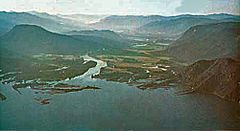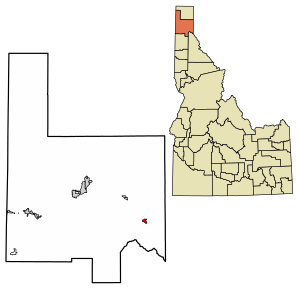Clark Fork, Idaho facts for kids
Quick facts for kids
Clark Fork, Idaho
|
|
|---|---|

Clark Fork (located to the left/north) of the Clark Fork River, which runs down the middle
|
|

Location of Clark Fork in Bonner County, Idaho.
|
|
| Country | United States |
| State | Idaho |
| County | Bonner |
| Area | |
| • Total | 0.98 sq mi (2.55 km2) |
| • Land | 0.98 sq mi (2.55 km2) |
| • Water | 0.00 sq mi (0.00 km2) |
| Elevation | 2,093 ft (638 m) |
| Population | |
| • Total | 536 |
| • Density | 587.82/sq mi (226.96/km2) |
| Time zone | UTC-8 (Pacific (PST)) |
| • Summer (DST) | UTC-7 (PDT) |
| ZIP code |
83811
|
| Area code(s) | 208, 986 |
| FIPS code | 16-14950 |
| GNIS feature ID | 2409468 |
Clark Fork is a small town located in Bonner County, Idaho. In 2010, about 536 people lived there. It's a peaceful place known for its natural beauty.
Contents
Where is Clark Fork Located?
Clark Fork is found in the northern part of Idaho, often called the "panhandle." It sits right on the Clark Fork River. This river then flows into the eastern side of Lake Pend Oreille, which is a very large and beautiful lake. The town covers a small area, about 0.92 square miles (2.55 square kilometers), and it's all land. A small stream called Lightning Creek also runs near the town.
A Look at Clark Fork's History
The land around Lake Pend Oreille has been home to the Kutenai Native American people for hundreds of years. They lived there long before Europeans arrived in North America.
The town of Clark Fork got its name from William Clark. He was a famous explorer who, along with Meriwether Lewis, led the Lewis and Clark Expedition in 1804. They explored the western parts of America. It's thought that Lewis and Clark saw the Clark Fork River near a place called Missoula, Montana, in 1805.
After the expedition, fur traders traveled through this area. The town really started to grow in the early 1880s. This was when the Northern Pacific Railway built a train line next to the Clark Fork River. By the 1890s, people used a ferry boat to cross the river or travel upriver to places like Heron, Montana.
Today, Clark Fork is a small town that focuses on farming and forestry (working with trees). It also has small local businesses. Tourism is important too, with activities like camping, hunting, and fishing bringing visitors to the area.
Clark Fork's Weather
Clark Fork has a type of weather called a humid continental climate. This means it has big differences in temperature throughout the year. Summers are usually warm to hot, and sometimes humid. Winters are cold, and can even be very cold.
Who Lives in Clark Fork?
| Historical population | |||
|---|---|---|---|
| Census | Pop. | %± | |
| 1920 | 325 | — | |
| 1930 | 432 | 32.9% | |
| 1940 | 430 | −0.5% | |
| 1950 | 387 | −10.0% | |
| 1960 | 452 | 16.8% | |
| 1970 | 367 | −18.8% | |
| 1980 | 449 | 22.3% | |
| 1990 | 448 | −0.2% | |
| 2000 | 530 | 18.3% | |
| 2010 | 536 | 1.1% | |
| 2019 (est.) | 579 | 8.0% | |
| U.S. Decennial Census | |||
In 2010, there were 536 people living in Clark Fork. These people lived in 260 households. About 95.5% of the people were White. A small number of people were Native American, Asian, or from other backgrounds. About 0.9% of the population was Hispanic or Latino.
The average age of people in Clark Fork was about 45.5 years old. About 21.6% of residents were under 18 years old, and 18.8% were 65 years or older.
Famous People from Clark Fork
Clark Fork has been home to some notable people:
- Ron Heller (born in 1963) was a professional football player. He played as a tight end in the NFL.
- Compton I. White (1877–1956) was a politician who served eight terms as a congressman for Idaho. A congressman is someone who represents their state in the U.S. government.
- Compton I. White, Jr. (1920–1998) was also a politician and served two terms as a congressman for Idaho, just like his father.
See also
 In Spanish: Clark Fork para niños
In Spanish: Clark Fork para niños

